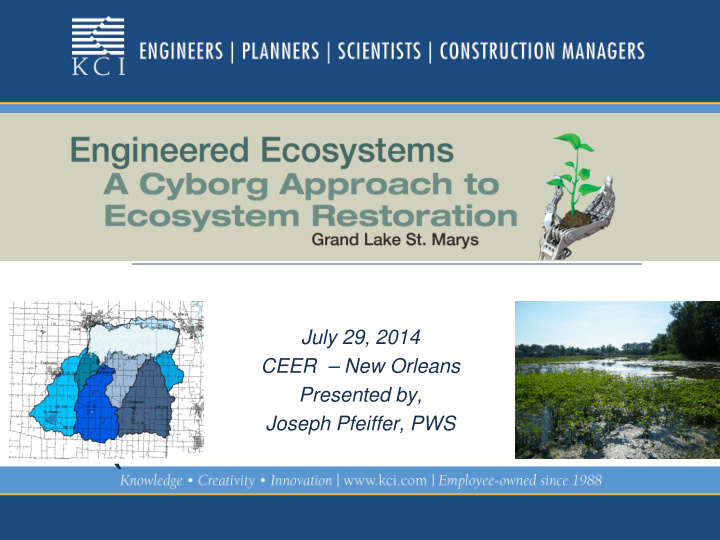



July 29, 2014 CEER – New Orleans Presented by, Joseph Pfeiffer, PWS `
Ecosystem State of Condition Historical Altered Novel *Seastedt, Hobbs, Suding: 2008
The Good, The Bad and The Ugly…. The Good Stable functioning ecosystems The Bad Degraded ecosystems The Ugly An ecosystem in a state that potentially creates direct threats to human health and well being
Altering the State of Condition Cyborg/Engineered Ecosystem Cyborg System – An integrated man machine system that restores function and/or enhances the abilities of the augmented entity to function. Ecosystem ICU Going on Life Support Engineered Ecosystem Map ecosystem pathways Identify limiting factors
Grand Lake St. Marys – Mercer County, OH Grand Lake St. Marys 21 square mile man made lake in West Ohio 52 square mile watershed 425 million in agricultural production 125 million in tourism Key issues Excessive nutrient loading resulting in Hypo-trophic condition in lake and watershed Blue Green algal blooms producing mycrosystin toxins
Grand Lake St. Marys – Mercer County, OH Impacts Algal blooms shut down all use of the lake in 2009/10 Estimated loss of $77 million to local economy Loss in housing value of 25 million No Freddie Mac/Fannie Mae funding for homes in proximity to lake Identified public health threat
Grand Lake St. Marys Strategic Plan Critical Response Actions Conceptual Ecosystem Revitalization Model Environmental Economic
Grand Lake St. Marys Littoral Wetland Restoration Critical Element in GLSM System Historically over 2,500 acres Lost due to; Water quality degradation Invasive species (carp) Anthroprogenic activities Restore by; Increase water clarity Reduce nutrient loading Establishing substrate
Littoral Wetland Restoration Engineered Ecosystem – Treatment Train Prairie Creek Treatment Train Engineered Mechanical Pumping o 1.3 MGD Chemical Dosing o Alum Bio-Technical Constructed Wetlands o 6 Acres Natural Restored Wetlands o 10 acres
Prairie Creek Treatment Train - PCTT MAID System Controls pumping into system Doses chemical as required Tracks water quality Ph Turbidity Flow rates Allows remote monitoring and control
Prairie Creek Treatment Train - PCTT Constructed Wetland Cells Five cells, alternating deep and shallow water
Prairie Creek Treatment Train - PCTT
Prairie Creek Treatment Train - PCTT Results 65% reduction in Total Phos 30% reduction in Total N Trophic shift in embayment
Prairie Creek Littoral Wetland - PCLW Basic Design Deep and shallow marsh system Designed to improve Fish and Wildlife habitat Will receive flow from PCTT Encapsulation of nutrient laden sediment
Littoral Wetland Restoration Engineered Ecosystem – Treatment Train Cold Water Creek Treatment Train Engineered Mechanical Pumping o 6 MGD Bio-Technical Constructed Wetlands o 40 acres Flow Diversion Natural Restored Wetlands o 250 acres
Conclusions Current Engineered Ecosystems on GLSM have shown; Observed and measured improvements in water quality Observed expansion of existing littoral wetland system On-going Ecosystem response to re-establishment in historic wetland zones still being monitored Future Two more Treatment Trains in design, four more in planning
QUESTIONS
Recommend
More recommend